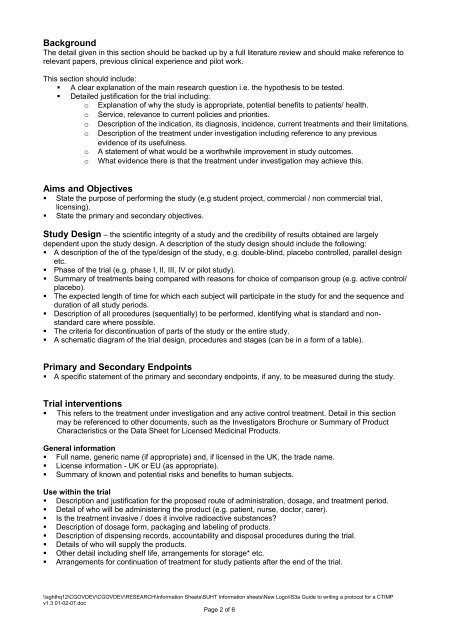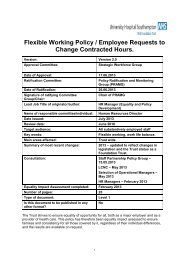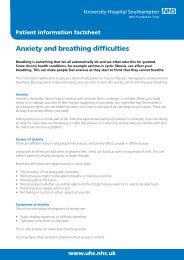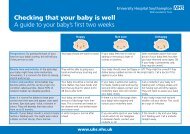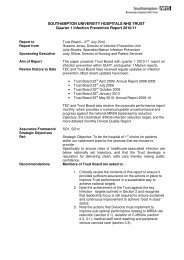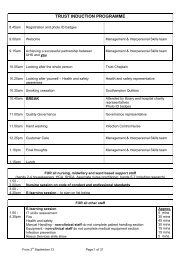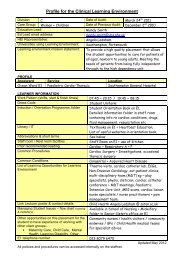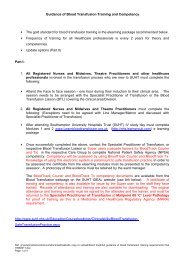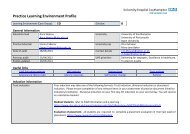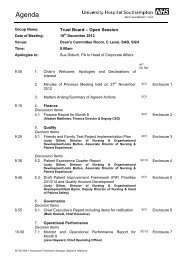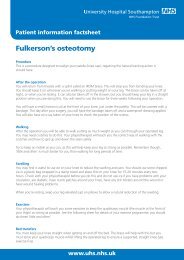Guide to writing a Clinical Trials Protocol - University Hospital ...
Guide to writing a Clinical Trials Protocol - University Hospital ...
Guide to writing a Clinical Trials Protocol - University Hospital ...
You also want an ePaper? Increase the reach of your titles
YUMPU automatically turns print PDFs into web optimized ePapers that Google loves.
BackgroundThe detail given in this section should be backed up by a full literature review and should make reference <strong>to</strong>relevant papers, previous clinical experience and pilot work.This section should include: A clear explanation of the main research question i.e. the hypothesis <strong>to</strong> be tested. Detailed justification for the trial including:o Explanation of why the study is appropriate, potential benefits <strong>to</strong> patients/ health.o Service, relevance <strong>to</strong> current policies and priorities.o Description of the indication, its diagnosis, incidence, current treatments and their limitations.o Description of the treatment under investigation including reference <strong>to</strong> any previousevidence of its usefulness.o A statement of what would be a worthwhile improvement in study outcomes.o What evidence there is that the treatment under investigation may achieve this.Aims and Objectives State the purpose of performing the study (e.g student project, commercial / non commercial trial,licensing). State the primary and secondary objectives.Study Design – the scientific integrity of a study and the credibility of results obtained are largelydependent upon the study design. A description of the study design should include the following: A description of the of the type/design of the study, e.g. double-blind, placebo controlled, parallel designetc. Phase of the trial (e.g. phase I, II, III, IV or pilot study). Summary of treatments being compared with reasons for choice of comparison group (e.g. active control/placebo). The expected length of time for which each subject will participate in the study for and the sequence andduration of all study periods. Description of all procedures (sequentially) <strong>to</strong> be performed, identifying what is standard and nonstandardcare where possible. The criteria for discontinuation of parts of the study or the entire study. A schematic diagram of the trial design, procedures and stages (can be in a form of a table).Primary and Secondary Endpoints A specific statement of the primary and secondary endpoints, if any, <strong>to</strong> be measured during the study.Trial interventions This refers <strong>to</strong> the treatment under investigation and any active control treatment. Detail in this sectionmay be referenced <strong>to</strong> other documents, such as the Investiga<strong>to</strong>rs Brochure or Summary of ProductCharacteristics or the Data Sheet for Licensed Medicinal Products.General information Full name, generic name (if appropriate) and, if licensed in the UK, the trade name. License information - UK or EU (as appropriate). Summary of known and potential risks and benefits <strong>to</strong> human subjects.Use within the trial Description and justification for the proposed route of administration, dosage, and treatment period. Detail of who will be administering the product (e.g. patient, nurse, doc<strong>to</strong>r, carer). Is the treatment invasive / does it involve radioactive substances? Description of dosage form, packaging and labeling of products. Description of dispensing records, accountability and disposal procedures during the trial. Details of who will supply the products. Other detail including shelf life, arrangements for s<strong>to</strong>rage* etc. Arrangements for continuation of treatment for study patients after the end of the trial.\\sghthq12\CGOVDEV\CGOVDEV\RESEARCH\Information Sheets\SUHT Information sheets\New Logo\IS3a <strong>Guide</strong> <strong>to</strong> <strong>writing</strong> a pro<strong>to</strong>col for a CTIMPv1.3 01-02-07.docPage 2 of 6


